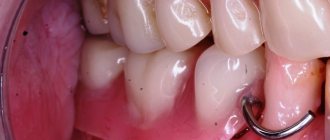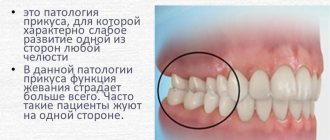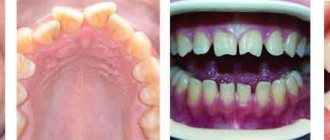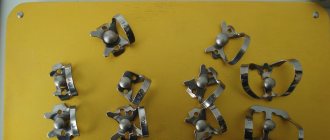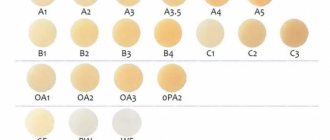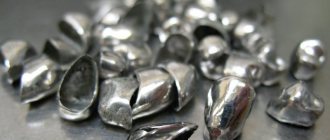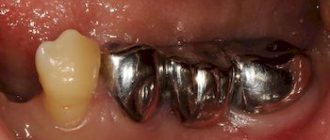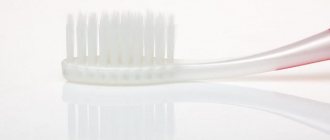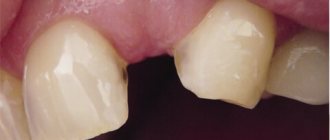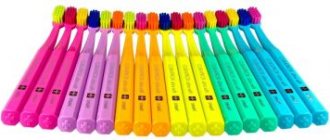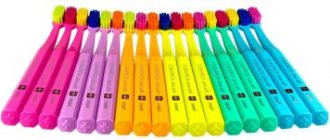Clasps or hooks on dentures: classification, what they are and how they are used
Article navigation
- What is it and what is it used for
- Classification
- Requirements
- Manufacturing
- Common clasp designs
- How to remove dentures
- Complications
- Alternatives
- Price
Question for a specialist
To fix removable dentures, dentists use various fasteners. One of the most common types is clasps or the most common hooks. Next, we will tell you in more detail about the types of clasps in orthopedic dentistry, about their purpose and structure, what functions they perform, and what requirements must be met when using them.
Anchor design
The popularity of the products is due to their design features. The mechanism is equipped with a rigid anchor of increased rigidity, which prevents movement of the prosthesis.
Characteristics:
- perpendicular placement of the onlay relative to the dental axis while simultaneously tilting the coronal area;
- the shoulder includes three elements (support - serves to stabilize the orthodontic apparatus; fixing part in the soft tissue area - provides elasticity; intermediate element - provides a clasp connection of medium rigidity).
It is used to eliminate defects accompanied by approximately equal separation of the outer and inner surfaces of the tooth. Due to the lack of springiness, the system is designed to be fixed exclusively between the chewing area and the dividing line.
Disadvantages of the Anker system:
- covering the dental unit with the shoulder, which increases the likelihood of accumulation of food debris;
- restrictions (the system is intended for molars only).
What is it and what is it used for
What is a clasp in dentistry? In German, klammer is a clamp, frame, bracket. In dentures, a clasp for removable dentures is an element of a partial denture, with the help of which the structure is attached to the abutment tooth and held on it. The simplest clasp looks like a small hook (that’s why such dentures are called “hooked”), but there are elements of more complex shapes. They are designed to fix and stabilize the prosthetic base - that is, the orthopedic structure must remain stable both at rest and during talking or chewing, during the process of swallowing food.
What does a clasp consist of? The design includes the following parts or elements - shoulders or rings, body and process, and in some cases the occlusal pad. Let's take a closer look at the structure of its components:
- shoulders or shoulder: this is an elastic part that covers the supporting tooth on the sides of the crown (instead of a shoulder there may be a ring) and is pressed against its gingival part, the shoulder itself smoothly passes into the body,
- the body is the connecting element between the shoulder and the process,
- the process is immersed in an acrylic base or attached to the arch of a clasp prosthesis,
- The occlusal pad is located on the chewing part of the crown between the tubercles of molars and premolars: it is a supporting element that helps to correctly distribute the chewing load. The pad is smoothly connected to the body,
- frontal overlay: the purpose is the same as the occlusal overlay, but it is placed on the front teeth (usually on the lingual side of the row, so as to be invisible from the side).
In turn, the shoulder is also divided into elements - the supporting and holding parts. The supporting one makes up approximately 70% of the length of the entire shoulder, and the holding one makes up the remaining 30%. The thickness of the clasp is on average 0.25-0.5 mm.
Clasps and boundary line
The choice of clasp for prosthetics directly depends on the position of the boundary line, for which there are five options:
- Location from the contact point in the defect area to the middle part of the proximal surface of the adjacent unit. In such cases, the use of Roach or Bonigrad models is recommended.
- The passage of the equator through the central part of the approximal region, with a smooth rise to the contact point of the adjacent element. Provides for the installation of an Acker support-retaining clasp.
- The diagonal position of the equator and the passage of an extended boundary line in the area of the defective chewing surface, with a tangential intersection of the supporting element and ending on the opposite side of the tooth neck. The preferred model is the Ney clasp.
- The high position of the equator, caused by increased abrasion of the enamel coating of the dentition. In such situations, the boundary line requires covering with artificial crowns, which allow restoring the natural anatomical shape.
- Low location of the boundary line in the presence of cone-shaped elements, with the equator located at the cervical level. Involves the use of supporting structures.
Types of clasps
Common models of retainers used in prosthetics include:
- A support-retaining clasp is a structure that combines two arms, a process and an occlusal lining, ensuring compliance with rigidity and thickness parameters that prevent fracture during operation. The prosthesis is fixed in the lower part, while the upper part, located above the center line, prevents the structure from moving. Similar models include Ney clasps, which do not require the installation of crowns during fixation, and are distinguished by their universal use for any condition of tooth enamel.
- Roach's clasp is a rod-type system with elongated arms that provide a springing effect and reduce the mechanical load on the dentition. They are distinguished by their aesthetics, ease of use with shortened crowns, as well as the ability to carry out retention procedures in various supporting areas of the dentition;
- The Acker clasp is a simple and affordable option used when installing clasp dentures, requiring supporting elements. As a rule, it is fixed on molars, which are distinguished by their rigidity and strength of structure;
- The Bonville clasp is a model whose design provides for installation using two occlusal-fissure pads, which ensure stabilization of the replacement system in case of elimination of unilateral defects, as well as if it is necessary to preserve antagonistic elements.
Classification and varieties
There are many types of classification of clasps - by function, shape, material of manufacture, method of connection with the prosthetic base, location of contact, degree of crown coverage, manufacturing methods. Let's look at each classification group in more detail.
By purpose or function
- retaining clasps: used in orthodontics (occlusion correction) and orthopedics (dental prosthetics). They have only 1 function - holding the plate or removable denture on the supporting crowns. When chewing, the entire load goes to the prosthetic base and gums, which can rub, resulting in pain and stomatitis. Another method of application is fixation of rubber dam (latex film for dental treatment),
- supporting-retaining (with an occlusal pad, for example): also options are also used in orthodontic and orthopedic treatment. However, they have 2 functions - holding and support. When chewing, the load will be distributed, among other things, to the supporting teeth, their ligaments and the adjacent bone (periodontal tissue). In this case, the mucous membranes “suffer” less.
Experts note that the division into retaining and support-retaining is conditional. Because retaining hooks also transfer part of the load to the periodontium. But in this case, the distribution of pressure is incorrect, so negative consequences often appear - injuries, loosening of teeth, loss of gums.
By shape
The following types of clasps are distinguished by shape:
- flat,
- tape,
- semicircular,
- round.
Don't know what type of prosthetics to choose?
We will help in the selection, advise where to read more information and compare types of prosthetics.
Consultation with an orthopedic doctor in Moscow clinics is free! Call now or request a call
Working hours: from 9:00 to 21:00 - seven days a week
According to the method of connection with the prosthesis base
The connection can be of the following types:
- stable, i.e. rigid: the hook, through which pressure is distributed on the crown, is fixedly attached to the prosthetic base. There is almost no load on the gums and alveolar ridge,
- springy or semi-labile: a distinctive feature is the presence of a long body that is capable of springing. Here, only part of the chewing load is applied to the crown, and the rest is absorbed due to the “lever effect”,
- articular or labile: due to the presence of a hinge (or joint), almost all the pressure from the prosthesis goes not to the support, but to the gum and alveolar ridge.
At the location of contact
Based on their location or location, these elements are divided into types such as:
- dental: adjacent to the crowns, most often made of metal,
- pelota or gingival: they are wide extensions of an acrylic base, fixed only on the gums,
- dentogingival: simultaneously in contact with the gums and supporting crowns. For example, immediate dentures or “butterflies” have these – what the clasps on a denture look like is shown in the photo.
According to the degree of coverage of dental crowns
- one-armed and two-armed,
- ring-shaped (also called “changeover”),
- double,
- multi-link clasp: is a frontal overlay (it was discussed at the beginning of the article) on the lingual surface of the front teeth - most often placed on the lower ones. Externally, a multi-link one looks like either a horizontal plate with processes or several united half rings. Helps stabilize an entire group of teeth.
According to the material of manufacture
Classification according to materials of manufacture includes such types of clasps as:
- from base metals: for example, from medical steel, nickel, cobalt alloys with chromium and iron, titanium alloys,
- from noble metals: platinum, gold, palladium,
- from synthetic polymers, resins: plastic, acrylic, nylon, acetal.
By manufacturing method
- bent clasps: for production, wire is used, which is bent in accordance with individual bite parameters. Such elements are more elastic or resilient, but fit less accurately to the crowns,
- cast: the manufacturing technique of casting also involves the use of metal. Cast metal clasps are less elastic, but more accurately replicate the anatomical parameters of the crown, i.e. fit tighter
- made using cold or hot polymerization: gingival ones are made from a synthetic polymer (acrylic, nylon, etc.), usually simultaneously with the manufacture of the prosthetic base.
NeoStom – Dentistry website
In addition to the clasps included in the Ney system, there are other varieties. All the different types of clasp fixation can be systematized depending on the design features of the holding arms of the clasps, i.e. directions of their retention endings.Types of clasps : The first group includes two subgroups of clasps with shoulders directed to the retention zone from the occlusion side, i.e. from the overlay. Most of them are relatively rigid clasp systems. The first group consists of double-armed and single-armed clasps. The second group includes clasps with shoulders directed to the retaining zone from the gum side. They are called rod clasps. They belong to springy (elastic) clasp systems.
The third group includes combined clasps, consisting mainly of the arms of the first and second groups, as well as a combination of rigid elements on the side of the occlusion and a wire arm. The first group - clasps with shoulders on the occlusion side, is divided into two subgroups: double-armed and single-armed. The first subgroup is double-arm clasps. The clasps belonging to this subgroup are built on the basis of the Acker clasp (Ney-I). Two-link (three-link) clasp. These are structures in which the vestibular and oral shoulders consist of several (2-3) links, with the last links on each side being retention ones. Due to the long length of the arms, they can be classified as flexible clasp systems.
Types of Acker clasp
a - two-link clasp; b - three-link clasp
There are cases when the tooth limiting the defect does not have a retention zone, but the adjacent tooth in front has a pronounced retention area. In such cases, two-link clasps are used. The first link is located on the tooth limiting the defect, above the boundary line, the second link is on the adjacent tooth below the boundary line, and the first link should be placed closer to the occlusal surface in order to cross the area of contact of both teeth without injuring the gingival papilla. Thus, the first links of the shoulders provide bilateral coverage of the tooth, and the second links provide retention. The three-link clasp is a combined design of a two-link clasp and an Acker clasp. Bonneville flip clasp. Reversible clasps include those structures that cross the occlusal surface in the transverse direction and are placed on the vestibular and oral sides of the abutment teeth. The Bonneville clasp is also called a double Acker clasp with arms directed in opposite directions. It is used on molars or on the second premolar and first molar with continuity of the dentition, for example, in Kennedy classes II and IV.
The upper or lower arches of the clasp denture are connected to the Bonville clasp using one connecting rod. In this case, the rod is placed vertically until it intersects with the boundary line, after which it continues into the gingival zone.
Bonneville switch clasp
The junction area of the four arms must be massive to withstand occlusal pressure. If there is no room to place the cast transverse parts of the clasp, then you can lightly grind the supporting teeth or antagonists for this. These clasps fill well the gaps (three spaces) between abutment teeth located at a small distance. In this case, they provide fixation of the prosthesis and are a contact point for adjacent teeth. In the Bonneville clasp, all four arms can be retaining, but it is possible to have two retaining and two stabilizing shoulders, located diagonally or bilaterally. Two occlusal pads on adjacent teeth provide sufficient support for the prosthesis and prevent the abutment teeth from moving apart (wedge-shaped action). In addition, occlusal linings prevent food from getting between the teeth. The Bonville clasp provides very good fixation, stabilization and support of the prosthesis, provided there is sufficient space between the antagonists. The embrasure clasp is a type of Bonneville clasp and also belongs to the reversible type. The clasp consists of two Acker clasps, having the opposite direction, in which the vestibular arms are shortened and look like hooks or hooks. They are placed in the occlusal zone and do not reach the boundary line. Consequently, they serve as stabilizing shoulders, and the two oral shoulders are retentive. If there are insufficient retention zones on the oral side, you should find corresponding retention zones on other teeth and additionally place clasps there.
Embrasure clasp
Embrasure clasps are also used for splinting mobile adjacent teeth. To do this, the oral arms of several clasps are connected to each other above the boundary line in a row of stabilizing arms. In this case, this system of clasps blocks all moving teeth and ensures their unloading from the vertical and horizontal components of chewing pressure. A double Acker clasp consists of two Acker clasps with shoulders directed towards each other. The two arms of this design are connected to form a two-link stabilizing arm, while the other two arms are retention arms. A clasp consisting of two opposing (oppositely directed) arms has two occlusal pads from which the arms extend. One or both shoulders may be retained. The clasp is used on single teeth when the retention zones are located diagonally. The arms of the clasp start from the medial and distal pads and are located depending on the boundary line on the vestibular and oral sides of the tooth. If one of the shoulders is stabilizing, then it is placed above the boundary line. The clasp can be used in one-sided dentures on the side of the continuous dentition.
a - double Acker clasp; b - clasp made of two opposing arms
Double clasp with occlusal pad on the adjacent tooth. A special feature of this design is the unusual arrangement of the main elements of the clasp on two teeth. In this case, the shoulders are placed on one tooth, used for coverage and retention, and the occlusal overlay is placed on the adjacent tooth, which is the supporting tooth. The mesio-distal clasp is used for splinting isolated anterior teeth with diastemas and trema. Such a clasp can be called a double-armed approximal clasp. Its shoulders cover the medial and lateral surfaces of the abutment tooth by more than 180°, which ensures fixation of the clasp.
The middle part of the clasp is supporting and is located above the guide line. Above the tubercle of the tooth, two short arms extend from it, with limited compliance. They should be placed in the gingival area almost under the very guide line, which makes their precise fit difficult. In order to strengthen the retention ends of the shoulders, they should be made relatively wide, but flat. When modeling a clasp, it should be kept in mind that the connecting rod must extend from the middle part of the clasp to contact the palatal plate, without touching the gingival margin.
a - two-arm clasp with an occlusal pad on an adjacent tooth; b — medio-distal clasp; c — shoulder-pin (“fish hook”) The use of mesio-distal clasps for the anterior teeth is advisable from an aesthetic point of view. However, placing the connecting rod in the middle of the oral surface of the tooth is their disadvantage, because there is a sensation of a foreign body interfering with the tongue. Shoulder stiletto. This name is due to the fact that one of the arms of the clasp has the shape of a hairpin. It is sometimes called a "fish hook". The clasp is used for use as retention of the near zone of the abutment tooth, i.e. in the case when, from the side of the defect, the boundary line approaches the occlusal surface. This occurs with medial inclination of single molars. Its retention arm (clasp) starts from the occlusal lining, with the covering part located above the boundary line, then the arm bends in the opposite direction, crosses the boundary line and ends in the retention zone. The clasp has a number of disadvantages that limit its use: • the shoulder covers a significant surface of the tooth, on which food can get stuck;
• elastic properties of the retaining end of the clasp arm are limited; • used only on molars. The second subgroup is single-arm clasps. Opposite rear action clasp (vestibular single-arm clasp). Considering the location of the connecting rod and the initial part of the clasp arm on the vestibular side of the dentition, it is advisable to call it a vestibular single-arm clasp. It is used in cases where the premolars on the lower jaw are inclined towards the tongue. Construction of prostheses using conventional types of clasp fixation is impossible, because on the vestibular side, premolars do not have a retention zone. On the oral side, on the contrary, there is a sufficient holding area, but there is no support zone that serves for the location of the rigid, enclosing elements of the clasp arms.
Opposite rear action clasp (vestibular single-arm clasp
The connecting rod starts from the area of the retention loops of the frame, does not touch the mucous membrane and, at the level of the abutment tooth, bends in the vertical direction until it connects with the clasp arm in the middle of the premolar. The vestibular part of the shoulder continues in the distal direction, in which the occlusal pad extends from it. This part of the shoulder is relatively rigid and provides coverage of the abutment tooth and stabilization of the prosthesis. It is used for Kennedy class I defects, providing a rational load on the supporting teeth, especially when they are mobile. The Swenson clasp is used on fangs. The occlusal pad is located on the medial side of the canine. The shoulder extends from the pad, curving down the tubercle and then up where it
Svenson clasp
near the cutting edge it passes to the vestibular surface and ends in the medio-vestibular zone. It is used for Kennedy class I defects, providing a rational load on the supporting teeth, especially when they are mobile.
Single-arm clasp with an occlusal pad on the adjacent tooth. If there is slight mobility of a tooth limiting a class I dentition defect according to Kennedy, it is not advisable to use it as support and retention. In this case, the clasp is placed on two adjacent teeth. A stable penultimate tooth is used for support, and a tooth limiting the defect in the dentition is used to fix the prosthesis on the jaw. The clasp arm covers the tooth on three sides and is elastic due to its large length.
a - double single-arm clasp for the upper jaw; b - double one-arm clasp for the lower jaw; c - single-arm clasp with an occlusal pad on the adjacent tooth. Double single-arm clasp for the upper jaw. It is used on the side of a continuous dentition, as well as with two isolated molars. The clasp is used when there is significant divergence of the molars, in which there is no retaining zone on the palatal side. The disadvantage of the design is the need for a gap between the premolar and molar to position the front arm of the clasp with a continuous row of teeth. Double one-arm clasp for the lower jaw. Used when there are two converging molars. It is similar to the previous system, but the condition for its use is the presence of favorable areas on the vestibular side of the alveolar process for the location of the connecting rod. Due to the lingual inclination of the two molars, both arms begin on the labial side, continue on the proximal sides, and end at the retentive ends near the contact of both molars.
Modifications of Roach's clasp.
a — C-shaped rod shoulder; b - i-shaped rod shoulder; c — L-shaped rod arm The clasp design is shown in the presence of converging four molars on both sides of the dentition, for example, 87178.
This subgroup also includes clasps of the Ney system: rear-action clasp (Ney-IV) and ring clasp (Ney-V). The second group is clasps with shoulders on the gum side (rod clasps). In their structure, the clasps of this group have elements of the Roach clasp (Ney-II). Thanks to the elongated arms, these clasps are classified as flexible (springy) clasp systems. They are sometimes called load crushers because... the elasticity of the clasp arms helps reduce the effect of the horizontal component of the chewing load on the supporting teeth. This group includes clasp systems with two rod arms on the oral and vestibular sides. Roach clasp with modified shoulder. The classic Roach clasp is used most often on single molars of both jaws. However, depending on the position of the tooth, different types of rod arms of clasps are used on the vestibular and oral sides, and the arms are designated by letters whose shape they resemble (C, G, i, T). When the gripping area on the supporting tooth is distant from the base, a rod shoulder is used, shaped like a horizontal letter “L”. If the grip zone is adjacent to the base, then a C-shaped rod arm can be used.
a — T-shaped arm of the Roach clasp; b — T-shaped rod arm of Bonigard
The retention areas of these shoulders have a small area of contact with the gingival zone of the abutment tooth. The fixation of the clasps can be increased by giving the ends of the rod arms a T-shape. The third group is combined clasp systems. If in the Acker clasp and its modifications both arms can be functionally retaining, or one of them is retaining and the other is stabilizing (reacting), then in combined clasps, which are a combination of the shoulders of the first and second groups, only one shoulder is retentional, and the second is always counteracting (stabilizing). Along with Roach, a number of authors point out the possibility of using small retaining areas near the neck of the tooth to retain the arms of clasps, for example, on canines and premolars that have a poorly defined equator on the vestibular side. Currently, the cast Bonigard rod arm is used, which, like the T-shaped arm of the Roach clasp, belongs to the split clasp systems. The T-shaped end of the Bonigard rod arm is placed entirely in the gingival zone, between the boundary line and the gingival margin. The Bonigard clasp is used only on the front teeth or premolars. In contrast, the T-arm of the Roach clasp is used on molars. It has a more elongated split part, which is located almost along its entire length on the vestibular or oral sides of the molar. Clasps of the third group are divided into two subgroups. The first subgroup includes clasp designs with one arm on the occlusion side and a second rod arm on the gingival side. The second subgroup also includes clasps with one arm on the occlusion side and a second wire arm. The first subgroup is clasps with one rod arm. A clasp with Acker and Roach shoulders (Ney-III) is described in the section “Clamps of the Ney system”. Double split clasp. This clasp design uses two supporting teeth. The retention part consists of two split shoulders located in the gingival zones of the teeth. The stabilizing arms of the clasp are also located on two teeth in the occlusal zones, i.e. above the boundary line. The clasp is used on the front teeth and premolars and ensures reliable fixation of the prosthesis.
Clasp with Acker and Bonigard shoulders. The clasp has on one side a long elastic retention arm of Bonigard, and on the other side it is opposed by a second, shorter and more pliable Acker's opposing arm, which protects the abutment tooth from displacement. The latter must cover the oral half of the tooth to ensure stabilization of the denture. Used on anterior teeth and premolars.
Clasps with one rod arm.
a - double split clasp; b - ring clasp and Bonigard shoulder; c - clasp with Akker and Bonigard shoulders; d — ring plummer and Bonigard shoulder; d - clasp with Acker shoulder and Fera rod shoulder. Oral lining and Bonigard shoulder. On the lingual (palatal) side of the front teeth there are multi-link onlays, and on the vestibular side of the abutment tooth, in the gingival zone, there is a Bonigard rod shoulder. Ring clasp and Bonygard shoulder. This combined clasp is used on single small premolars of both jaws, when the retention arm of the ring clasp, due to its short length, cannot provide elasticity. In this case, a Bonygard holding rod shoulder is used in combination with an opposing rigid shoulder and two pads. The latter are connected with the help of branches to the frame on the upper jaw or to the clasp on the lower jaw. Clasp with Acker shoulder and Fehr rod shoulder. In this system, the end of the rod arm in the shape of a half ring, located in the gingival zone of the canine or premolar, is the retention end. This half-ring is connected to a support rod, which is loop-shaped to provide elasticity to the shoulder. The rigid Acker arm serves as a counteraction in the clasp, covering the tooth from the oral side and connecting to the occlusal pad. When modifying the Fehr design, it is possible to use a vestibular rod shoulder together with an Acker shoulder, an oral lining, or a ring clasp, i.e. in the same combination as when using the Bonigard rod arm.
The second subgroup is clasps with one wire arm. Acker shoulder and wire shoulder. In this system, the retentive arm is the wire arm, and the counteracting arm is the Acker arm. The wire shoulder absorbs functional loads before the supporting tooth receives them. It can be soldered to a frame made of a cobalt-chromium alloy or cast together with a frame made of a gold-platinum alloy, and can be attached to the base in the usual way. The most rational is the use of wire clasps for class I dental defects according to Kennedy. Oral pad and wire shoulder. In this system, the retention arm is the wire arm, and the stabilizing arm is the oral (palatal, lingual) pad. In class I dentition defects, when multi-link onlays are used on all remaining teeth, wire shoulders are located on the vestibular side of the supporting teeth, which well fix the prosthesis on the jaw. Ring clasp and wire arm. This clasp is used on single premolars or molars, when, due to the small vestibular curvature of the abutment tooth, it is necessary to use a wire arm that secures the prosthesis well. In addition, the clasp is used to transfer the load along the axis of the abutment tooth. To do this, two pads are placed on it, and to reduce the horizontal component of the chewing load, a pressure distributor in the form of a wire arm is used.
Clasps with one wire arm.
a - Acker shoulder and wire shoulder; b — oral lining and wire shoulder; c - ring clasp and wire arm The choice of clasp is influenced by the position of the boundary line identified during parallelometry. There are five main types of boundary lines that are more common. 1. The boundary line runs in the middle of the approximal line and rises along the vestibular surface of the tooth to the contact point with the adjacent tooth. This arrangement of the equator line will allow you to conveniently place the Acker support-retaining clasp on the tooth.
2. The boundary line begins at the level of the contact point of the tooth on the side of the dentition defect and along the vestibular surface descends to the middle of the proximal surface of the adjacent tooth. In this case, it is recommended to use clasps with long retaining arms, Roach clasps, Bonigard clasps. 3. Diagonal location of the equator on the supporting tooth. The equator passes near the chewing surface in the area of the dentition defect, obliquely crosses the vestibular surface of the supporting tooth and ends at the neck of the tooth on the opposite side. If it is a premolar, then a type 4 clasp according to Ney’s classification is used, and if it is a molar, a Ney ring clasp is used. Both clasps have long arms; due to their elasticity, they easily pass the equator of the abutment tooth, providing good fixation of the prosthesis and transmission of chewing pressure along the axis of the tooth. 4. When teeth are worn out, the equator is located high, it passes at the level of the chewing surface. Such teeth need to be covered with artificial crowns that restore their anatomical shape. 5. A low outline of the equator line is found in teeth that have the shape of a truncated cone. The equator passes at the level of the tooth neck. Such a tooth can only be used for a supporting clasp, otherwise it is necessary to restore its anatomical shape with a crown. Clinical and functional requirements for the natural tooth crown selected for the location of the support-retaining clasp: 1. The tooth must be stable. In case of pathological mobility of teeth, they should be blocked with adjacent teeth to form a stable system. Teeth with chronic periapical inflammatory foci can be used for support only after successful root canal filling.
2. Teeth must have a distinct anatomical shape. Teeth with a low cone-shaped crown, exposed neck and a sharp violation of the ratio of the length of the clinical crown and root are unsuitable for clasp fixation. These disadvantages are relative contraindications. After special preparation, such teeth can be included in the support of the clasp system. 3. It is necessary to take into account the relationship of the supporting tooth with the antagonist. This relationship can be so close that even a small occlusal pad placed in a fissure on the occlusal surface will disrupt the bite. In such cases, you should choose another tooth to place the supporting element or make a crown on the supporting tooth.
You might be interested in:
- Arch of a clasp prosthesis
- Telescopic fixation system
- Beam fixation system
- Locking system
- Anchor fixation system
Related materials:
- Ney system clasp
- Clasp structure
- Planning the design of a clasp prosthesis
- Prosthetics with clasp dentures
Requirements for hook placement
Denture clasps must be selected in accordance with all of the following requirements:
- the fixation will be the same on all supporting teeth,
- rotation or overturning of the prosthesis is excluded,
- do not overestimate the bite in the presence of occlusal pads,
- do not lead to injury to the teeth (including those of the opposite or antagonistic teeth) when closing the jaws and chewing,
- do not greatly reduce the aesthetics of a smile: metal ones located in the “smile zone” are highly noticeable from the outside, while synthetic ones are less noticeable. But the latter quickly stretch and break more often,
- the supporting teeth do not have pathological mobility,
- crowns of correct anatomical shape and sufficient height (5 mm or more).
You also need to take into account the position of the boundary line - this is the line that divides the crown into supporting and retaining parts. This parameter is determined using a parallelometer device. So, for example, on the lower teeth, the upper part of the clasp (occlusal pad and top of the shoulder) is located above the boundary line, and the lower part of the shoulder falls below the line. On the upper jaw, everything is, accordingly, the opposite.
Side effects from clasps
Denture clasps can cause:
- To the abrasion of the tooth enamel itself due to constant load and micro-movements.
- This leads to a significant deterioration in the hygienic condition of the mouth due to the fact that the clasp is a separate structure and various food debris can accumulate under it. As a result, carious processes begin to develop very quickly. And this destroys the supporting teeth.
- Clasps can cause teeth to become very loose. This happens due to the movements of the prosthesis in a horizontal position. As a result, there is a functional overload of the teeth, which serve as support.
Sources used:
- Kurlyandsky V. Yu. Orthopedic dentistry. — 4th, corrected. - M.: Medicine, 1977.
- Eden SE; Kerr WJS; Brown J. (2002). "A clinical trial of light cure acrylic resin for orthodontic use." Journal of Orthodontics.
- Earls, Stephanie (22 February 2014). "Re-enactor brings George Washington to life." The Washington Times.
- Milward, P.; Katechia, D.; Morgan, M. Z. (November 2013). "Knowledge of removable partial denture wearers on denture hygiene". British Dental Journal.
How is production carried out?
Manufacturing is carried out in a dental laboratory by a dental technician. First, the model of the prosthesis and materials are determined. As a rule, both metal wire and cast hooks are bent using special pliers, pliers and round nose pliers. Then the clasp is included in the base and the entire structure is tried on the patient; if necessary, the product is modified. During the manufacturing process, it is important to comply with the requirements for the manufacture of the shoulder and the implementation of the contact process. Thus, the shoulder should not overload the supporting tooth, but should adhere to the crown at the maximum number of points. The metal is well polished so that the hook does not injure the enamel and does not become a place where plaque accumulates. As for the process, it is bent with round nose pliers and notches are made for better connection with the base.
Overview of modifications
Common models of retainers used in prosthetics include:
- A support-retaining clasp is a structure that combines two arms, a process and an occlusal lining, ensuring compliance with rigidity and thickness parameters that prevent fracture during operation. The prosthesis is fixed in the lower part, while the upper part, located above the center line, prevents the structure from moving. Similar models include Ney clasps, which do not require the installation of crowns during fixation, and are distinguished by their universal use for any condition of tooth enamel.
- Roach's clasp is a rod-type system with elongated arms that provide a springing effect and reduce the mechanical load on the dentition. They are distinguished by their aesthetics, ease of use with shortened crowns, as well as the ability to carry out retention procedures in various supporting areas of the dentition;
- The Acker model is a simple and affordable option used when installing clasp dentures, requiring supporting elements. As a rule, it is fixed on molars, which are distinguished by their rigidity and strength of structure;
The Bonville clasp is a model whose design provides for installation using two occlusal-fissure pads, which ensure stabilization of the replacement system in case of elimination of unilateral defects, as well as if it is necessary to preserve antagonistic elements.
Common clasp designs
- Ney's system: there are 5 types of clasps - Acker, Roach, combined (from Acker and Roach designs), single-arm reverse action, single-arm ring. This system was developed in 1949 with the participation of dentists and engineers. It includes both already known fastenings (modified) and new ones,
- developed by Acker: a supporting-retaining element with a rigid connection, consisting of 2 arms, an occlusal pad and a body. One of the oldest and most famous varieties, which first appeared in 1926,
- Roach: a support-retaining device with an occlusal pad and a spring (elastic) connection, which is easy to distinguish from others - its two arms look like the letter “T”. Because of this similarity, the hook is called “split”. Made from cobalt-chromium and gold-platinum alloys,
- Bonneville: Also known as the “six-arm” because it consists of 4 arms and 2 occlusal pads. Fixes 2 teeth at once,
- Jackson: includes 2 branches and 2 bodies, made of wire,
- Adams: one of the most versatile and effective types, suitable for both free-standing teeth and those included in segments,
- arrow-shaped Schwartz clasp: consists of 1 or 2 links, can also be multi-link. It is made of elastic wire and fits well into the interdental spaces.
%akc72%
Clasp functions
The main purpose of clasp-type retainers is retention - holding the prosthesis in place during use. The clamps are a support that does not allow the structure to move in the direction of the mucosa; they counteract the force of lateral pressure and, to a small extent, the load along the vertical axis.
The shoulders contribute to the clamping of the support unit. Together, these functions ensure reliable fastening of the denture, which minimizes inconvenience during use and improves the quality of life.
Ney system
The methods were introduced into orthodontics by Ney in the middle of the last century. These are classic support-retaining clamps. They contain a process, two shoulder elements and an occlusal type overlay.
To minimize fastener fracture, the areas located closer to the base were made thicker and stronger, while the distant sections gradually became thinner, and the product took on the shape of a horn.
Ney devices include the following options:
- Single-armed.
- Forked Roach.
- Acker with two shoulders.
- Ring single-arm.
- Combined.
General characteristics include practicality, wear resistance, and high aesthetics.
Acker's clasp
One of the most effective and affordable fasteners. Installed on molars in the absence of one or more chewing elements and intact supports. Simple in design, it reliably keeps clasp dentures from moving.
The rigidity of the model’s frame can be considered both a plus and a relative minus, depending on the situation.
Various types of clasps
Complications that may arise due to clasps
Negative consequences or complications associated with prosthesis attachments can occur for various reasons. These include low-quality materials, errors at the manufacturing or installation stage, and non-compliance with operating rules. You may also be allergic to metal or synthetic materials. In patients who already have dentures made of other metals in their mouths, galvanosis often occurs - the sensation of an electrical impulse. Often chips and cracks appear in the enamel, gums bleed and recede, and the necks of the teeth are exposed.
If oral hygiene is unsatisfactory, pieces of food become trapped under the hooks, plaque and tartar form. This provokes caries, periodontitis, causes an unpleasant odor and generally worsens the aesthetics of a smile.
Basics of making a clasp
Clasps are made by technologists who focus on the prosthesis that will be installed on the patient. The manufacturing technology goes through the following sequence of actions:
- the clasp is essentially a hook that secures the prosthesis, so it is given the desired shape using specialized forceps, round nose pliers or pliers;
- first, a shoulder is formed that covers the dental crown;
- then the body itself is formed.
Dental technicians make the necessary bends to form clasps quickly and accurately, in just a few bends.
What alternatives exist
An alternative to clasp fixation are attachments (clasps) and telescopic crowns. All of these options are used for removable dentures. Dentists note that orthopedic structures on attachments are fixed better, and they themselves are completely invisible from the outside. As for telescopic crowns, this is also a very good option, but it is considered the most difficult to manufacture.
“Mom wore a clasp denture for several years. It seemed convenient, but outwardly the metal hooks on the teeth stood out. Well, she began to smile less, of course, because of this. Then the prosthesis had to be changed, and the doctor persuaded me to use attachments. “He turned out to be much better in beauty, from the outside he looks like his own teeth and no hooks are visible.”
Lina O., review from the website stomatology.rf
If we consider the best option for prosthetics in principle, then here the first place is firmly held by dentures fixed on implants - fixed or conditionally removable. They have many advantages - strong, reliable and durable fastening, highest aesthetics, comfort when chewing (they feel like your “native” teeth).
Read on the topic: conditionally removable dentures on implants - how they are attached and how they differ from others.
Design features
Retaining type clasps consist of the following elements:
- The shoulder performs the function of holding the clasp on the tooth surface. This element ensures the spring properties of the structure and the transfer of pressure to the support unit. The shoulder should not have sharp protrusions to avoid injury to the gum tissue and cheek.
- The body is an element of the product placed on the surface of the tooth and connecting the shoulder and the process of the clasp.
- The process performs the function of fixing the fastening in the prosthetic structure. Placed under the plastic components of the hook.
In support-retaining clasps, in addition to the shoulder and body, there is an occlusal pad that prevents tooth displacement when pressure occurs on it, and an anchor part - an element connecting the clasp to the metal base.
How much does prosthetics cost?
The cost of prostheses with hook fixation is the lowest in the segment. For example, a “butterfly” prosthesis can cost from 6,500 rubles, a removable acrylic one from 15 thousand rubles. Much here depends on the length of the orthopedic structure, the type and material of the fastening, the number of clasps, and the base material.
1Glen P. McGeevey Partial Dentures, 2006.
Your questions and answers
QUESTION Hello, tell me, which prosthesis with clasps is better to install? Irina T.
ANSWER Hello, Irina. The choice of prosthesis will depend on the condition and number of supporting teeth, as well as the capabilities of the clinic and the patient’s preferences. With clasps you can make a removable partial denture, acrylic, Acry-free, nylon, acetal, or clasp denture. Better reliability and more compact sizes are found in classic clasp frames, as well as in their modern metal-free counterparts Quattro Ti (“Quadrotti”).
Author: Chernov A. R. (Thank you for your help in writing the article and the information provided)
Caring for clasp dentures
A dental patient gets used to the prosthesis in about two days. At the initial stage, problems with diction may arise, but this goes away after getting used to it and some exercises. There may also be problems when eating - pain and control of food intake at the initial stage. It is better to exclude hard and sticky foods from the diet while adapting to the prosthesis. It is also not recommended to remove the denture at night, as this will allow the oral cavity to quickly adapt to the changes.
Cleaning and rinsing of the prosthesis is performed twice a day with special products prescribed by the attending physician. Storage of the prosthesis excludes water; it is simply placed in a special container.
If the prosthesis is damaged, you must contact a dental clinic or dental laboratory, where work on the repair of clasp dentures is carried out. Sometimes restoration of the prosthesis takes several hours - with prompt treatment. Most often, clinics provide guarantees for the installation and for the prosthesis itself, so repairs can be free.
The Faberge dental laboratory in St. Petersburg provides dental services. We are ready to provide all the information you are interested in about our production, the technologies used and the specialists. With us you will receive first-class products of any kind.
Pros and cons of nylon
There are also nylon - one-piece dentures with clasps for attaching to abutment teeth
The main positive quality of nylon is the ability to create any shade, so it is easy for the dentist to choose the color of the base. Clasps for nylon dentures are poured simultaneously with the base, so they merge and do not stand out when you smile. The thin layer of plastic is not felt when chewing and talking.
But some patients are dissatisfied with nylon prostheses with clasps:
- atrophy of gum tissue and its subsidence are possible;
- dentures deteriorate faster and become deformed;
- sometimes there is pain when biting and chewing;
- you have to visit the dentist more often for correction;
- the likelihood of developing infections, stomatitis, and gingivitis increases.
More modern versions of Acry-free from an Israeli manufacturer are manufactured using software and scanning of the oral cavity. They are distinguished by high aesthetics, perfectly follow the contours of the gums, therefore they are invisible and practical. Suitable for full or partial dentures, replacement of dentures with metal clasps.
Possible problems
If the execution technology is violated, undesirable consequences may occur:
— when moving horizontally, the material can put a lot of pressure on the dental units, which makes them excessively mobile;
- the enamel surface may collapse due to minor damage;
— the clasp can cause the formation of pathogenic microflora in the mouth due to food particles accumulating under it.
Important! If something bothers you, do not endure it - contact your dentist.
